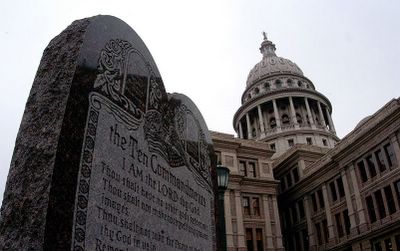"To be, or not to be ?" ...Excellent Question!
Ah, a conundrum. Do we take down the Ten Commandments monument on the Texas State Capital’s property because it has religious connotations, or do we leave it there because it has historical significance? To be honest with you, I can’t decide at this point. Perhaps by the time I get to the bottom of the page I’ll have convinced myself one way or the other.
First of all, does it have historical significance? Well, the Ten Commandments have been around a lot longer than Texas as we know it, so you can’t say that we had a hand in the forming of them (and that’s not the kind of thing us Texans like to admit). But did the Commandments help form Texas? In a way, yes. The core of America’s laws are basically the same as most of the commandments. Don’t kill. Don’t steal. Leave others’ mates alone. The only ones not mimicked are the ones dealing specifically with spiritual faith, and we purposely left those out with the very first amendment to our national Constitution.
Let’s consider that First Amendment. It states:
Congress shall make no law respecting an establishment of religion, or prohibiting the free exercise thereof; or abridging the freedom of speech, or of the press; or the right of the people peaceably to assemble, and to petition the Government for a redress of grievances.
Back when this was written, the term "freedom" wasn’t tossed around caually or used as rhetoric like it is now. Back then, they didn’t have these freedoms, which is why they told the British to take a hike (or sail). They wanted to make sure that if they were starting their own government, then they ought to do it right.
One of those freedoms was the freedom to worship as they chose. Remember that they fled an England with an official government religion, and non-participants didn’t have the same opportunities as those within The Church. Also at the time, the colonists were clustered mostly by culture. Different states were predominated by different sects – here a Presbyterian, there an Episcopalian, everywhere a Quaker, etc. There was very real concern that whoever was in power would push their values and prejudices on other states, and whoever held the dominant belief system would also be able to retain power in the new government.
It appears that that they made the religion portion of the amendment intentionally vague, as none of the initial versions contained the "respecting the establishment of religion" part. Madison proposed "nor shall any national religion be established". The House altered that to read "''Congress shall make no law establishing religion". The Senate adopted "''Congress shall make no law establishing articles of faith, or a mode of worship". The present language was written by a committee containing both bodies and chaired by Madison.
"Respecting the establishment of religion" can be interpreted in many ways. If the initial offerings from all parties involved are taken as the authors' intentions, it appears to mean "not establishing a national religion". But the wording of the final version can be construed to mean "not showing respect to one or more religious establishments", i.e. churches, faiths, etc.. Therein lies the controversy, which has sparked interesting debates and contradictory legislation.
Before we leave the subject of Constitutional Ammendments, allow me to climb upon my soapbox and mention that only once in our history has a Constitutional Ammendment been ratified that actually took away freedom (on moral grounds, of course), and that led to the prohibition era. Now there's another push for a freedom-reducing ammendment - this one intended to make non-traditional marriage illegal. Draw your own conclusions.
Now let's look at the circumstances surrounding the Ten Commandments monument in the Texas Capital. The monument was donated in 1961 by the Fraternal Order of Eagles and was accepted by the Texas State Legislature. It could be argued that by accepting the monument, the legislature was demonstrating the will of the people, although its debatable whether any legislature actually represents the will of the people.
Since 1951, FOE had been distributing written copies of the Commandments in hopes of combatting juvenile delinquency. In 1956, Cecille B. DeMille was promoting his new movie, The Ten Commandments, and convinced the group to donate carved stone tablets like the ones featured in his movie instead. The monuments began appearing in front of city halls, county courthouses, public parks and state capitals across America. Coincidentally, or not, The Ten Commandments was reissued to theatres in 1961, about the time the monument was erected halfway between the Texas State Capital and the Texas Supreme Court building. The movie has since gone on to become the 5th top grossing film of all time (when ticket sales are adjusted for inflation).
The monument shares space on the capital grounds with 16 other monuments, which pay tribute to - among others - WWI, Korean War and disabled veterans, Pearl Harbor, the Statue of Liberty, Confederate soldiers, Alamo heroes, pioneer women, children, cowboys, peace officers and volunteer firefighters.
Now that we have the background you can see why the Supreme Court is in a conundrum. Is the monument a religious symbol, and if so, does it violate the first ammendment? Or is it a cultural icon that has a place in Texas history?
I gotta say, I can't call how the SC is gonna fall on this one, but I say "Let it Be", even though my progressive brethren may crucify me.
Because this isn't about wingnuts or moonbats, Christians or Athiests.
This isn't like toppling statues of Saddam in Baghdad. If we knock this statue down, which one's next? The Confederate Soldiers, because they lost? Pioneer Women, because the stereotype embodies the barefoot, pregnant ideal that fundamentalists fantasize about, even though the truth is drastically different?
And beyond Texas? Do we tear down the Lincoln Memorial, because his Emancipation Proclamation only freed slaves below the Mason-Dixon line, and not above it? The Washington Monument, because he owned slaves and grew cannabis? The Clinton Presidential Library, to appease the anti-doublewide coalition? The Statue of Liberty, just because it was given to us by the French?
History is full of incongruities which helped us mature as a nation. Sure, if a symbol from our sordid past represents oppression, suppression, discrimination or any other "shun", let's erase it so we can move on. But a monument given in the spirit of social improvement should not be torn down unless it's a detriment to the promotion of a free society. And given the ambiguity built into the first amendment, this particular one doesn't appear to be breaking any laws.
Of course that's my opinion, and I could be wrong. Let me know, America. Call 1-800-LACTOSE. Operators are standing by.







2 Comments:
Hmmm, although I've seen the monument in question numerous times, the picture you posted has shown me a new perspective on this - the monument, or "graven image", is directly outside the "font of goodness", or Texas captial, that houses the infamous Texas legislature. How many of their commandments do they break on a regular basis? I'm not all that familiar with them but I'll take a shot:
"Thou shalt not bear false witness" - duh, this is the Texas legislature, right?
"Honor thy parents" - CPS is a disater, Medicaid (nursing homes) is in crisis
"Thou shalt not commit adultery" - hmmm
"Thou shalt not kill" - DUH
"Thou shalt not covet" - including thy neighbor's House or Senate seat? So much for the world of advertising...
& wasn't there a commandment against worshipping graven images?
Any more? Could we maybe hang a "do as we say, not as we do" disclaimer on this or something?
By Anonymous, at 3:34 PM
Anonymous, at 3:34 PM
All very good points. And yes, I believe there is one about worshipping idols. But I've never seen anyone worshipping this monument (at least not in public).
Granted, the monument hasn't done the lawmakers any good, but the debate is about whether it does the rest of us harm.
By Anonymous, at 1:34 PM
Anonymous, at 1:34 PM
Post a Comment
<< Home